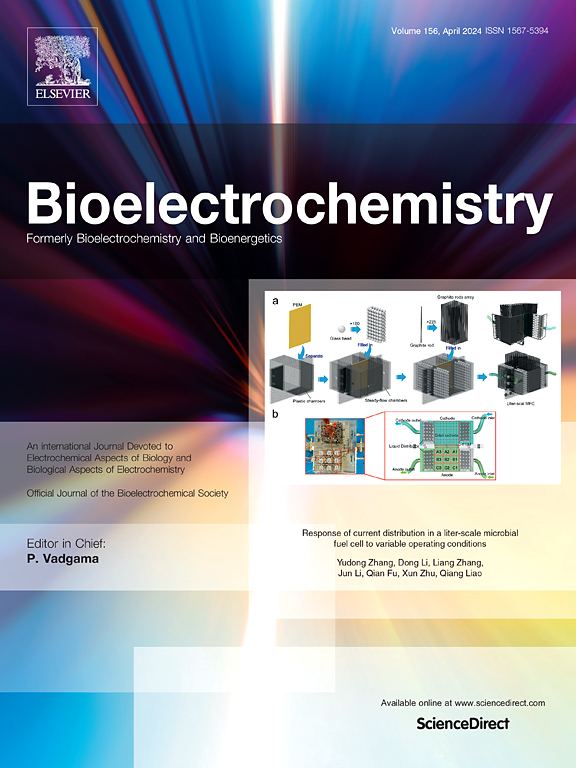电化学阻抗体外感知外伤性脑组织诊断与治疗。
IF 4.8
2区 化学
Q1 BIOCHEMISTRY & MOLECULAR BIOLOGY
引用次数: 0
摘要
创伤性脑损伤(TBI)引起严重影响人类日常活动的神经生殖功能障碍,早期诊断是预防和治疗的关键要求。在这里,我们通过机械方法(超声波清洗剂产生的抽搐休克,UGCS)和化学方法(戊四氮,PTZ)诱导斑马鱼(一种模式生物)形成TBI。通过电化学技术测量超氧阴离子(O2-)和谷氨酸盐等生物标志物的活性,监测脑外伤诱导的细胞和神经元变化。为此,α-硫辛酸(α-LA, LA)功能化的金银(LA- au /Ag)被用作电化学传感器来诊断生理磷酸盐缓冲盐水(PBS, pH 7.4)、0.1 M KCl溶液和TBI组织中这些标记物的存在。在0.2-0.5 V电位窗口观察到谷氨酸的氧化,而在0.6-1.0 V电位窗口观察到金属介导的O2-氧化。该传感器对O2- (4 ~ 48 μM, LOD为4 μM)和谷氨酸(20 ~ 130 μM, LOD为19 μM)具有良好的线性范围。TBI组织修饰电极的电阻比正常脑组织(对照)(NBT)低,这是由于O2-的存在量较高,并且在[Fe(CN)6]3-/4-存在下发生Fenton反应和Heber-Weise反应。将LA-Au/Ag纳米颗粒送入经UGCS和PTZ处理的斑马鱼体内,通过循环伏安法和阻抗谱法监测电化学信号的变化。电化学数据进一步证实了超氧化物歧化酶(SOD)、过氧化氢酶(CAT)和脂质过氧化物酶(MDA)的活性。该方法的发展为创伤性脑损伤的早期诊断和治疗提供了新的选择。本文章由计算机程序翻译,如有差异,请以英文原文为准。
In-vitro sensing of traumatic brain tissue by electrochemical impedance for diagnosis and therapeutic
Traumatic brain injury (TBI) induces neurogenerative disorders affecting severely daily human activities and early diagnosis is a critical requirement for prevention and cure. Here, we induced TBI formation in the Zebra fish, a model organism, by both mechanical (ultrasonic cleaner generated convulsive shock, UGCS) and chemical (pentylenetetrazol, PTZ) methods. The TBI induced cellular and neuronal changes are monitored by measuring the activities of the indicator biomarkers viz., superoxide anion (O2![]() −) and glutamate by electrochemical techniques. For this, the α-lipoic acid (α-LA, LA) functionalized gold-silver (LA-Au/Ag) is used as an electrochemical sensor to diagnose the presence of these markers in physiological phosphate buffer saline (PBS, pH 7.4), 0.1 M KCl solutions and in TBI tissues. While the oxidation of glutamate is observed in the potential window 0.2–0.5 V, the metal mediated oxidation of O2
−) and glutamate by electrochemical techniques. For this, the α-lipoic acid (α-LA, LA) functionalized gold-silver (LA-Au/Ag) is used as an electrochemical sensor to diagnose the presence of these markers in physiological phosphate buffer saline (PBS, pH 7.4), 0.1 M KCl solutions and in TBI tissues. While the oxidation of glutamate is observed in the potential window 0.2–0.5 V, the metal mediated oxidation of O2![]() − is observed at the potential window 0.6–1.0 V. The sensor showed good linear ranges for O2
− is observed at the potential window 0.6–1.0 V. The sensor showed good linear ranges for O2![]() − (from 4 to 48 μM with the LOD of 4 μM for the O2
− (from 4 to 48 μM with the LOD of 4 μM for the O2![]() − detection) and glutamate (from 20 to 130 μM with the LOD 19 μM). The TBI tissue modified electrode showed lower resistance than the normal brain tissue ((NBT), as control) due to the presence of higher amount of O2
− detection) and glutamate (from 20 to 130 μM with the LOD 19 μM). The TBI tissue modified electrode showed lower resistance than the normal brain tissue ((NBT), as control) due to the presence of higher amount of O2![]() − and occurrence of Fenton’s and Heber-Weise’s reactions in the presence of [Fe(CN)6]3−/4−. For theragnostic application, the LA-Au/Ag nanoparticles is delivered into the UGCS and PTZ treated Zebrafish and electrochemical signal changes are monitored by cyclic voltammetry and impedance spectroscopy. Electrochemical data further corroborated with the activities of superoxide dismutase (SOD), Catalase (CAT) and lipid peroxidase (MDA) in parallel. The developed method of electrochemical sensing of TBI may provide alternative for the early TBI diagnosis and therapeutics for the prevention of TBI.
− and occurrence of Fenton’s and Heber-Weise’s reactions in the presence of [Fe(CN)6]3−/4−. For theragnostic application, the LA-Au/Ag nanoparticles is delivered into the UGCS and PTZ treated Zebrafish and electrochemical signal changes are monitored by cyclic voltammetry and impedance spectroscopy. Electrochemical data further corroborated with the activities of superoxide dismutase (SOD), Catalase (CAT) and lipid peroxidase (MDA) in parallel. The developed method of electrochemical sensing of TBI may provide alternative for the early TBI diagnosis and therapeutics for the prevention of TBI.
求助全文
通过发布文献求助,成功后即可免费获取论文全文。
去求助
来源期刊

Bioelectrochemistry
生物-电化学
CiteScore
9.10
自引率
6.00%
发文量
238
审稿时长
38 days
期刊介绍:
An International Journal Devoted to Electrochemical Aspects of Biology and Biological Aspects of Electrochemistry
Bioelectrochemistry is an international journal devoted to electrochemical principles in biology and biological aspects of electrochemistry. It publishes experimental and theoretical papers dealing with the electrochemical aspects of:
• Electrified interfaces (electric double layers, adsorption, electron transfer, protein electrochemistry, basic principles of biosensors, biosensor interfaces and bio-nanosensor design and construction.
• Electric and magnetic field effects (field-dependent processes, field interactions with molecules, intramolecular field effects, sensory systems for electric and magnetic fields, molecular and cellular mechanisms)
• Bioenergetics and signal transduction (energy conversion, photosynthetic and visual membranes)
• Biomembranes and model membranes (thermodynamics and mechanics, membrane transport, electroporation, fusion and insertion)
• Electrochemical applications in medicine and biotechnology (drug delivery and gene transfer to cells and tissues, iontophoresis, skin electroporation, injury and repair).
• Organization and use of arrays in-vitro and in-vivo, including as part of feedback control.
• Electrochemical interrogation of biofilms as generated by microorganisms and tissue reaction associated with medical implants.
 求助内容:
求助内容: 应助结果提醒方式:
应助结果提醒方式:


